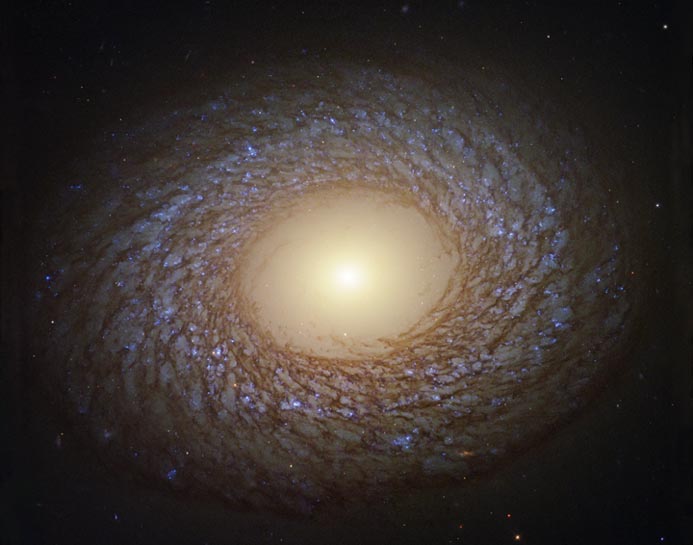
Spiral Galaxy
RA 9h 10m 20.23s Dec 7° 2' 17.07"
Cancer
65 million light years
10.1
4.3 x 3.3 arcmin
2.58 x 2.21 arcminutes
North is 60.1° right of vertical
ESA/Hubble & NASA, J. Lee and the PHANGS-HST Team
June 29, 2020
ABOUT
THIS IMAGE:
The spiral pattern shown by the galaxy in this image from the NASA/ESA Hubble Space Telescope is striking because of its delicate, feathery nature. These "flocculent" spiral arms indicate that the recent history of star formation of the galaxy, known as NGC 2775, has been relatively quiet. There is virtually no star formation in the central part of the galaxy, which is dominated by an unusually large and relatively empty galactic bulge, where all the gas was converted into stars long ago.
NGC 2775 is classified as a flocculent spiral galaxy, located 67 million light-years away in the constellation of Cancer.
Millions of bright, young, blue stars shine in the complex, feather-like spiral arms, interlaced with dark lanes of dust. Complexes of these hot, blue stars are thought to trigger star formation in nearby gas clouds. The overall feather-like spiral patterns of the arms are then formed by shearing of the gas clouds as the galaxy rotates. The spiral nature of flocculents stands in contrast to the grand design spirals, which have prominent, well defined-spiral arms.
From Wikipedia:
NGC 2775 (also known as Caldwell 48) is a spiral galaxy in the northern constellation of Cancer, located at a distance of 67 megalight-years from the Milky Way. It was discovered by William Herschel on December 19, 1783. NGC 2775 belongs to the Antilia-Hydra Cloud of galaxies and is the most prominent member of a small galaxy group known as NGC 2775 group, part of the Virgo Supercluster, along with the Local Group. Other members of the NGC 2775 group include NGC 2777 and UGC 4781.
This object has a morphological classification of SA(r)ab, which indicates an unbarred spiral galaxy (SA) with a prominent ring structure (r) and flocculent, tightly-wound spiral arms (ab). The galaxy is inclined by an angle of 44° to the line of sight from the Earth. The galactic nucleus is not active and the large nuclear bulge, which extends out to an angular radius of 0.4', is relatively gas free. An explanation for the latter could be a high supernova rate. Although star formation is taking place in the dusty outer ring, the galaxy does not display any current starburst activity.
The galaxy has a hydrogen tail feature indicates a past interaction with a faint companion. A satellite galaxy appears to have orbited NGC 2775 multiple times, losing mass as it does so and creating faint, shell-like structures. Nearby irregular galaxy NGC 2777 displays a tidal tail of hydrogen gas that points back to NGC 2775, suggesting the two may be linked.
SN1993z
is the only supernova known to have occurred in NGC 2775, which was detected
September 23rd, 1993 at a magnitude of 13.9, and was classified as a Type
Ia supernova. By the 25th, its spectra showed that it had peaked four
weeks earlier.